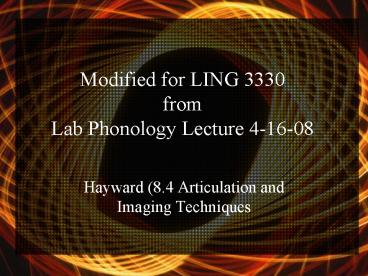Modified for LING 3330 from Lab Phonology Lecture 41608 - PowerPoint PPT Presentation
1 / 36
Title: Modified for LING 3330 from Lab Phonology Lecture 41608
1
Modified for LING 3330 from Lab Phonology
Lecture 4-16-08
- Hayward (8.4 Articulation and Imaging Techniques
2
- http//www.ling.fju.edu.tw/phonetic/descriptive_an
swers.htm
3
Articulators Muscles (review)
- From Ladefoged Vs and Cs 2nd ed.
4
Articulators Muscles (review)
5
Palatography
- Palatography a traditional method of measuring
tongue contact with the roof of the mouth. - Use medicinal charcoal and olive oil to paint
the tongue for a palatogram that shows where
the tongue touched the palate. - Using the paint on the palate the part of the
tongue that did the touching can be studied.
Linguagram - after an articulation pictures are taken of the
palate (using a mirror) and the tongue
6
Palatography
- From Ladefoged Vs and Cs 2nd ed.
7
Palatography
- From Ladefoged Vs and Cs 2nd ed.
8
Palatography
- From Ladefoged Vs and Cs 2nd ed.
9
Palatography
- From Ladefoged Vs and Cs 2nd ed.
10
Palatography
- From Ladefoged Vs and Cs 2nd ed.
11
Electropalatography
- http//speech.umaryland.edu/epg.html
- http//www.ling.mq.edu.au/speech/physiology/epg/ep
gnotes.html
12
Electropalatography
- my pal al saw the S.S. Pinafore
- http//speech.umaryland.edu/epg.html
13
Electropalatography
- Advantages
- real time tracking of tongue/palate articulators
- more sensitive than charcoal method
- Disadvantages
- possibly not very portable ( compared to charcoal
method needs batteries and computers) - possibly expensive per speaker for custom mouth
device - device could in fact affect articulation by
obstructing the actual contact between tongue and
palate - cannot show articulations outside of
alveolar-palatal ridge and soft palate (i.e.
labial, nasal, etc.)
14
X-ray
- http//www.phonetik.uni-muenchen.de/hoole/kurse/m
ovies/xray/l77_04.mov - its ten below outside
- In ten below there is a similar pattern of
movement by tongue and lips. An additional
consideration is the movement of the soft palate.
At the point where the lips close, the soft
palate is still open (it had to be open for the
/n/, of course), so in effect something like an
/m/ is articulated briefly, until the soft palate
raises to close the velopharyngeal port and allow
air-pressure to build up for the /b/. - 05_its_10_below.mov (small)
15
X-ray films
- Why do x-ray films constitute an important speech
resource? - X-ray filming is even today effectively the only
imaging technique that allows all the most
important speech articulators (jaw, tongue, lips,
soft palate, larynx) to be captured in a single
view at a frame rate that is reasonably adequate
for speech. However, in most countries it is no
longer considered ethically acceptable to make
cineradiographic recordings of speech with
healthy subjects, unless there is some clear
clinical indication for the recordings. Thus
existing x-ray films form an irreplaceable source
of information on speech. - From http//www.phonetik.uni-muenchen.de/hoole/ku
rse/movies/xray/xrayreadme.pdf
16
X-ray
- Benefit of X-Ray
- see the whole hard and soft tissue
- not affected by air in oral cavity
- thus can see interaction of multiple articulators
- larger scope for viewing area
- Draw back
- multiple still frame (films)
- potentially dangerous
- not likely to be portable
17
Microbeam X-ray
- http//www.medsch.wisc.edu/ubeam/
- Two nose pellets (MAXN, MAXG) and a maxillary
incisor (MAXI) pellet are used as references data
translation to a cranial coordinate system. Jaw
articulation is tracked via pellets on the
mandibular incisor (MANI) and mandibular molar
(MANM). Soft tissue pellets are placed on upper
lip (UL), lower lip (LL), tongue tip (TT), two on
the tongue blade (TB1, TB2), and tongue dorsum
(TD).
18
Microbeam X-ray
- The animation below illustrates the acoustic and
articulatory change during the production of the
diphthong in "light". An orange line joins the
four tongue points. Movements of the mandible are
represented by the two mustard-coloured points,
the upper and lower lip by the red points. Black
lines represent the front portion of the palate
and the rear wall of pharynx. (Data
visualization by xassp.) http//www.personal.uni-j
ena.de/x1siad/uwxrmbdb.html
19
Microbeam X-ray
- Advantages
- tracking of articulators in reference to jaw and
skull - more real time imaging
- Disadvantages
- only one exist (in Wisconsin)
- radiation exposure
- probably expensive and requires trained personnel
- weighs 15tons ? not portable
20
Electromagnetic Mid-sagittal Articulography
- http//www.articulograph.de/
- http//www.articulograph.de/AG500/mark-tiede.mov
(inaction)
21
Ultrasound
http//www.u-aizu.ac.jp/wilson/
22
http//www.lingref.com/cpp/gasla/8/paper1497.pdf
23
A midsagittal ultrasound image of the tongue
(prominent white line tongue surface)
24
UltrasoundStabilization
- http//speech.umaryland.edu/ahats.html
http//homepages.nyu.edu/7Eld43/Papers/LD_PD_Veri
fication_v4.pdf
25
Ultrasound Laterals
- little
- little
- red
26
Ultrasound Laterals
- Little Red Riding-Hood ran away with her lollipop
27
Vowel Review
28
Vowel Review
29
Ultrasound Vowels
- heed x2
- hid x3
- hayed x3
- head x3
- had x3
- hod x3
- hawed x3
- hoed x3
- hood x3
- whod x3
- HUD x3
- herd x3
- a hoyed x3
30
Ultrasound 3D
- it ran a lot it rang a lot
31
Ultrasound
- Harmonica file
32
Ultrasound
- Advantages of Ultrasound
- more portable
- less hazardous (less radiographic exposure)
- real time image
- possible 3D imaging (not as limited by air)
- Drawbacks
- cant see through air
- obstructed by bone
- smaller viewing area
33
MRI
- Ladefoged VC
34
MRI
- video from Ladefoged VC
- http//www.phonetics.ucla.edu/vowels/chapter11/ton
gue.html
35
MRI
- Benefits of MRI
- multiple cross sections allowing for detailed 3D
images - Real Time images
- Large viewing area
- Drawbacks
- Not portable
- highly trained personnel to operate
- very expensive
- potential radiographic exposure ?
- time consuming
36
Speech Imaging References
- Electropalatography
- http//speech.umaryland.edu/epg.html
- ultrasound
- http//speech.umaryland.edu/funmovies.html
(harmonica) - http//speech.umaryland.edu/3dmovies.html (3D)
- http//libproxy.uta.edu2103/10.1016/j.bandl.2006.
06.079 (article from science direct) - x-Ray
- http//psyc.queensu.ca/munhallk/05_database.htm
- http//www.phonetik.uni-muenchen.de/hoole/kurse/m
ovies/xray/xrayreadme.pdf - MRI
- http//speech.umaryland.edu/MICSR.html































